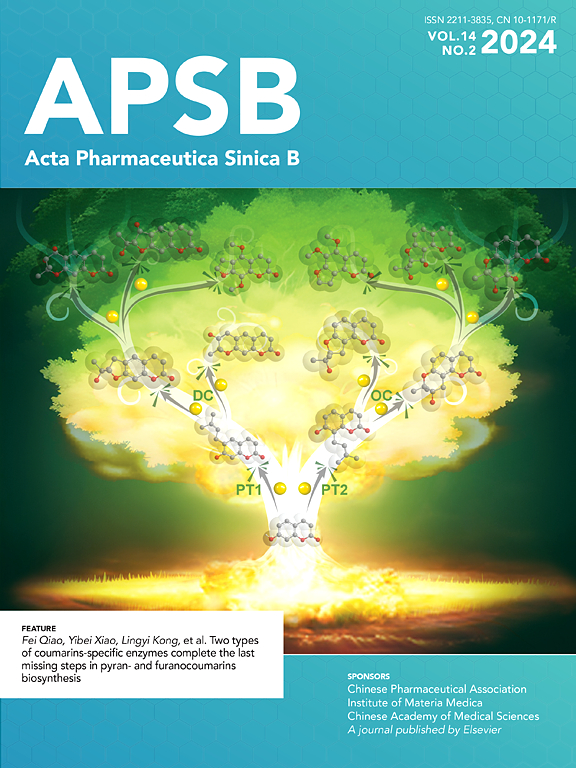通过光催化激活bivo4包埋二氧化硅纳米并级联下调GPX4/xCT轴,KRAS突变体结肠癌靶向诱导铁凋亡
IF 14.6
1区 医学
Q1 PHARMACOLOGY & PHARMACY
引用次数: 0
摘要
克尔斯滕大鼠肉瘤病毒(KRAS)是人类癌症中一种常见的致癌基因。大约40%的结直肠癌(CRC)患者具有KRAS突变,对靶向分子治疗和EGFR抗体治疗表现出强烈的耐药性。在这项研究中,我们提出了光催化二氧化硅纳米颗粒(A6-FS/BiVO4 DMSNs),用于靶向治疗KRAS突变型CRC,诱导级联性铁死亡事件。树突介孔二氧化硅纳米颗粒(DMSNs)由光催化BiVO4浸染,负载铁致凋亡剂(苯甲酰二茂铁:B和索拉非尼:S),并编码cd44 -靶向A6肽。为了进行靶向设计,我们使用CPTAC数据分析观察了KRAS突变的CRC细胞中CD44的过表达。激光照射后,A6-FS/BiVO4 DMSNs产生电子空穴对(e−/h+),产生羟基自由基(OH·)和超氧阴离子(O2·−)。激光照射同时引发铁(Fe2+)与苯甲酰二茂铁的解离和索拉非尼的释放。该级联可诱导KRAS突变型CRC细胞铁凋亡,特别是在氧化还原调节蛋白(胱氨酸/谷氨酸反转运蛋白和谷胱甘肽过氧化物酶4)有条件抑制的情况下,并在KRAS突变型CRC异种移植动物模型中显著抑制肿瘤生长。本文章由计算机程序翻译,如有差异,请以英文原文为准。

KRAS mutant colon cancer-targeted induction of ferroptosis via photocatalytic activation of BiVO4-embedded silica nano with cascadic downregulation of GPX4/xCT axis
Kirsten rat sarcoma virus (KRAS) is a common oncogene in human cancers. Approximately 40% of the patients diagnosed with colorectal cancer (CRC) have KRAS mutations that exhibit strong resistance to targeted molecular therapy and EGFR antibody treatment. In this study, we present photocatalytic silica nanoparticles (A6-FS/BiVO4 DMSNs) for targeted therapy of KRAS mutant CRC with the induction of cascadic ferroptosis events. Dendritic mesoporous silica nanoparticles (DMSNs) were impregnated with photocatalytic BiVO4, loaded with ferroptotic agents (benzoyl ferrocene: B and sorafenib: S), and encoded with CD44-targeting A6 peptides. For the targeting design, we observed CD44 overexpression in KRAS mutant CRC cells using CPTAC data analysis. Upon laser irradiation, A6-FS/BiVO4 DMSNs generate electron–hole pairs (e−/h+), which produce hydroxyl radical (OH·) and superoxide anions (O2·−). Laser irradiation simultaneously initiates the dissociation of iron (Fe2+) from benzoyl ferrocene and the release of sorafenib. This cascade induces ferroptosis in KRAS mutant CRC cells, especially under conditional inhibition of redox-regulating proteins (cystine/glutamate antiporter and glutathione peroxidase 4), and significantly inhibits tumor growth in a KRAS mutant CRC xenograft animal model.
求助全文
通过发布文献求助,成功后即可免费获取论文全文。
去求助
来源期刊

Acta Pharmaceutica Sinica. B
Pharmacology, Toxicology and Pharmaceutics-General Pharmacology, Toxicology and Pharmaceutics
CiteScore
22.40
自引率
5.50%
发文量
1051
审稿时长
19 weeks
期刊介绍:
The Journal of the Institute of Materia Medica, Chinese Academy of Medical Sciences, and the Chinese Pharmaceutical Association oversees the peer review process for Acta Pharmaceutica Sinica. B (APSB).
Published monthly in English, APSB is dedicated to disseminating significant original research articles, rapid communications, and high-quality reviews that highlight recent advances across various pharmaceutical sciences domains. These encompass pharmacology, pharmaceutics, medicinal chemistry, natural products, pharmacognosy, pharmaceutical analysis, and pharmacokinetics.
A part of the Acta Pharmaceutica Sinica series, established in 1953 and indexed in prominent databases like Chemical Abstracts, Index Medicus, SciFinder Scholar, Biological Abstracts, International Pharmaceutical Abstracts, Cambridge Scientific Abstracts, and Current Bibliography on Science and Technology, APSB is sponsored by the Institute of Materia Medica, Chinese Academy of Medical Sciences, and the Chinese Pharmaceutical Association. Its production and hosting are facilitated by Elsevier B.V. This collaborative effort ensures APSB's commitment to delivering valuable contributions to the pharmaceutical sciences community.
 求助内容:
求助内容: 应助结果提醒方式:
应助结果提醒方式:


